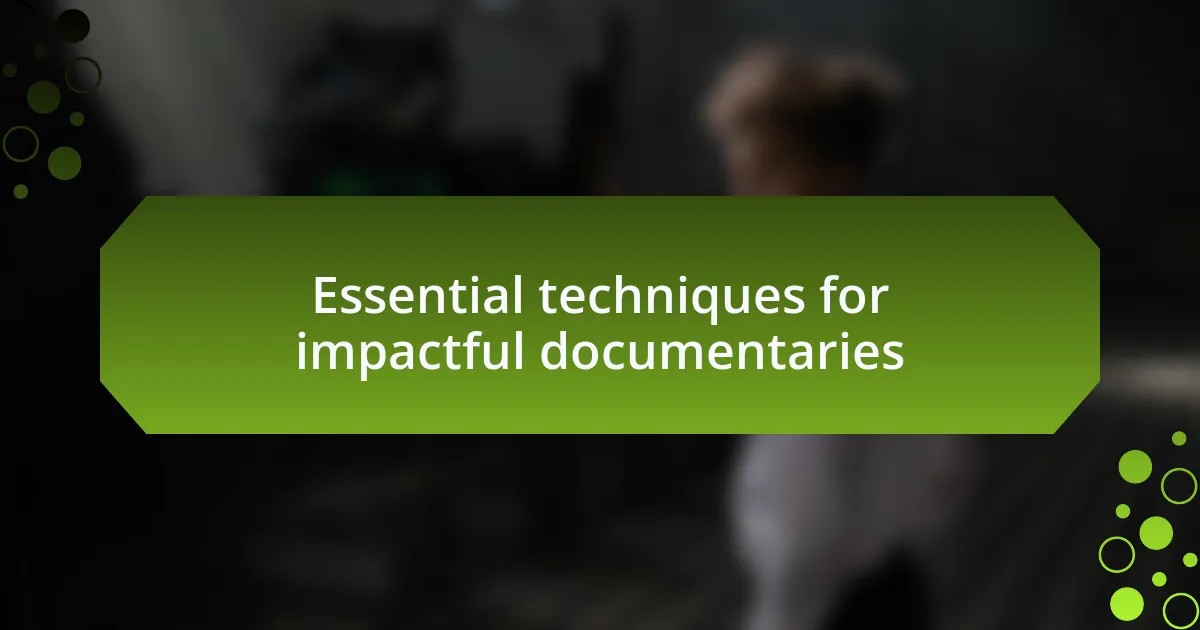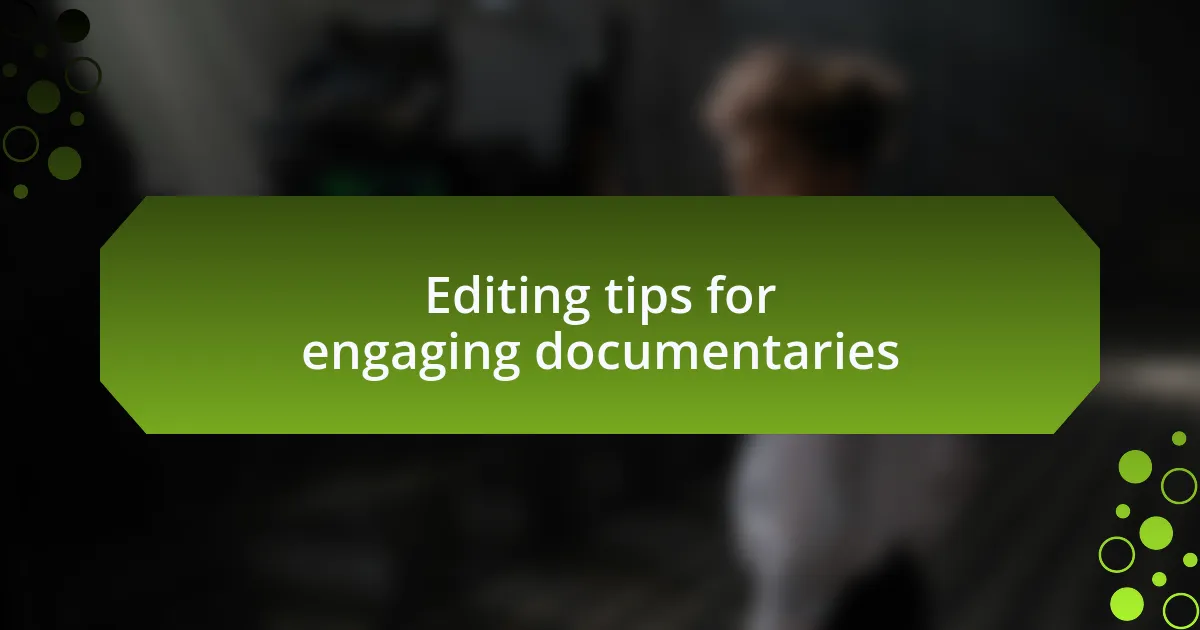Key takeaways:
- Documentary filmmaking benefits from immersive storytelling, observational techniques, and blending interviews with archival footage to convey authenticity and emotional depth.
- Compelling visuals and sound design are crucial for creating impactful documentaries, as they evoke emotions and enhance viewer connection to the subject matter.
- The art of editing plays a vital role in shaping the narrative, using pacing and transitions to maintain engagement and emotional weight.

Understanding documentary filmmaking strategies
Documentary filmmaking often relies on a range of strategies to convey truth while telling a compelling story. Personally, I’ve found that one effective approach is immersing oneself in the subject matter, much like a journalist would. This not only builds rapport with the subjects but also provides a deeper understanding that can infuse the narrative with authenticity.
Another strategy I appreciate is the use of observational techniques, which often remind me of standing in the midst of a vibrant scene and just letting the moment unfold. It’s fascinating to see how these films capture spontaneous emotions and interactions that scripted content might miss. Doesn’t it make you wonder how much richer our understanding of life can be when we simply observe and record, rather than direct?
Moreover, the layering of interviews over archival footage can create a unique narrative depth. I recall a documentary that delved into a historical event, combining personal stories with actual footage. It struck me how powerful this technique is—it invites viewers to connect emotionally while providing factual context. This blend of past and present asks us to reflect: how do the stories we tell shape our understanding of reality?

Importance of storytelling in documentaries
The heart of any impactful documentary lies in its storytelling. I remember watching a documentary that chronicled a family’s struggles, and the way the story unfolded made me feel as if I was right there with them, experiencing their highs and lows. What struck me was how the narrative arc helped to humanize complex issues, transforming statistics into relatable experiences. Isn’t it incredible how a well-told story can forge connections with audiences, transcending barriers of time, culture, and experience?
Crafting a compelling narrative allows filmmakers to weave facts into a story that resonates emotionally. There was a documentary I viewed that focused on climate change, but instead of drowning viewers in statistics, it presented the story through a fisherman who lost his livelihood due to rising sea levels. Seeing the real-life effects of an abstract concept was profoundly moving. This raises the question—how can we shift our perspective on serious topics by focusing on individual stories?
Ultimately, storytelling in documentaries isn’t just about presenting information; it’s about creating an experience that lingers in our minds. I often find myself reflecting on documentaries that highlight the human experience, like those that follow artists or activists. These narratives pull me in and make me ponder not just the subject matter, but how their journeys can inspire change. In what ways do the stories we choose to tell influence our perceptions of the world around us?

Essential techniques for impactful documentaries
Using compelling visuals is vital in creating impactful documentaries. I vividly recall a scene in a documentary that used breathtaking aerial shots to showcase the vastness of a national park, contrasted with the harsh realities of climate change encroaching on it. Those visuals struck me harder than words ever could, prompting reflection on how beauty and vulnerability coexist in our world. How do you think powerful imagery can deepen our emotional connection to a subject?
Another technique worth mentioning is the effectiveness of interviews to bring authenticity to the storytelling. I recently watched a documentary where the filmmaker captured raw, unfiltered testimonies from individuals affected by mental health issues. This approach provided a voice to those often marginalized, allowing me to hear their stories directly. When you listen to someone share their truth, don’t you feel a greater sense of empathy and understanding?
Finally, sound design plays an essential role in setting the tone and mood of a documentary. I remember being captivated by how background music swelled during pivotal moments, heightening emotional stakes and drawing me deeper into the film’s narrative. The right soundtrack can evoke feelings of hope, sorrow, or urgency. Have you ever noticed how a particular piece of music can stay with you long after the credits roll? Sounds not only complement the visuals but enhance the overall experience, making the documentary linger in our hearts and minds.

Using visuals to enhance narratives
Imagery in documentaries can transform a simple narrative into a profound experience. I remember a film that interspersed stark images of deforestation with close-ups of rainforest wildlife. Seeing the animals in their natural habitat, contrasted with the destruction around them, stirred a deep sadness within me. Has there ever been a visual that made you reconsider your stance on an issue?
The use of color and composition can also play a critical role in how a story unfolds. For instance, a documentary I watched used monochromatic tones to convey the gravity of a political crisis. Each shot felt heavy with meaning, and as I absorbed those visuals, I couldn’t help but feel the weight of the people’s struggles. How does color influence your perception of a visual narrative?
Finally, time-lapse photography presents a unique opportunity to encapsulate change over time. I was particularly moved by a piece showing the slow, yet relentless advance of urbanization over decades. Watching once-vibrant landscapes alter into concrete jungles left me reflective about our choices as individuals and communities. Have you ever felt the impact of time passing in a way that altered your perspective?

Editing tips for engaging documentaries
Editing is the backbone of an engaging documentary. I recall working on a project where I had to assemble hours of footage into a coherent narrative. It was fascinating to see how careful pacing could build tension or evoke empathy. Have you ever noticed how a well-timed cut can change the emotional weight of a scene?
Transitions are another crucial element in maintaining viewer interest. I experimented with various techniques, such as crossfades and jump cuts, to see how they affected the flow of the story. During one segment, a sudden jump cut to a subject’s expressive face created a powerful moment that drew viewers right in. What editing choices have left a lasting impression on you?
Incorporating sound effectively enhances the editing process as well. In my experience, layering ambient sounds or poignant music under key scenes can elevate the emotional resonance. I once used a haunting melody beneath a sequence of a community rallying together, and the combination left viewers on the edge of their seats. Have you ever felt that a documentary’s sound design made you feel more connected to its message?